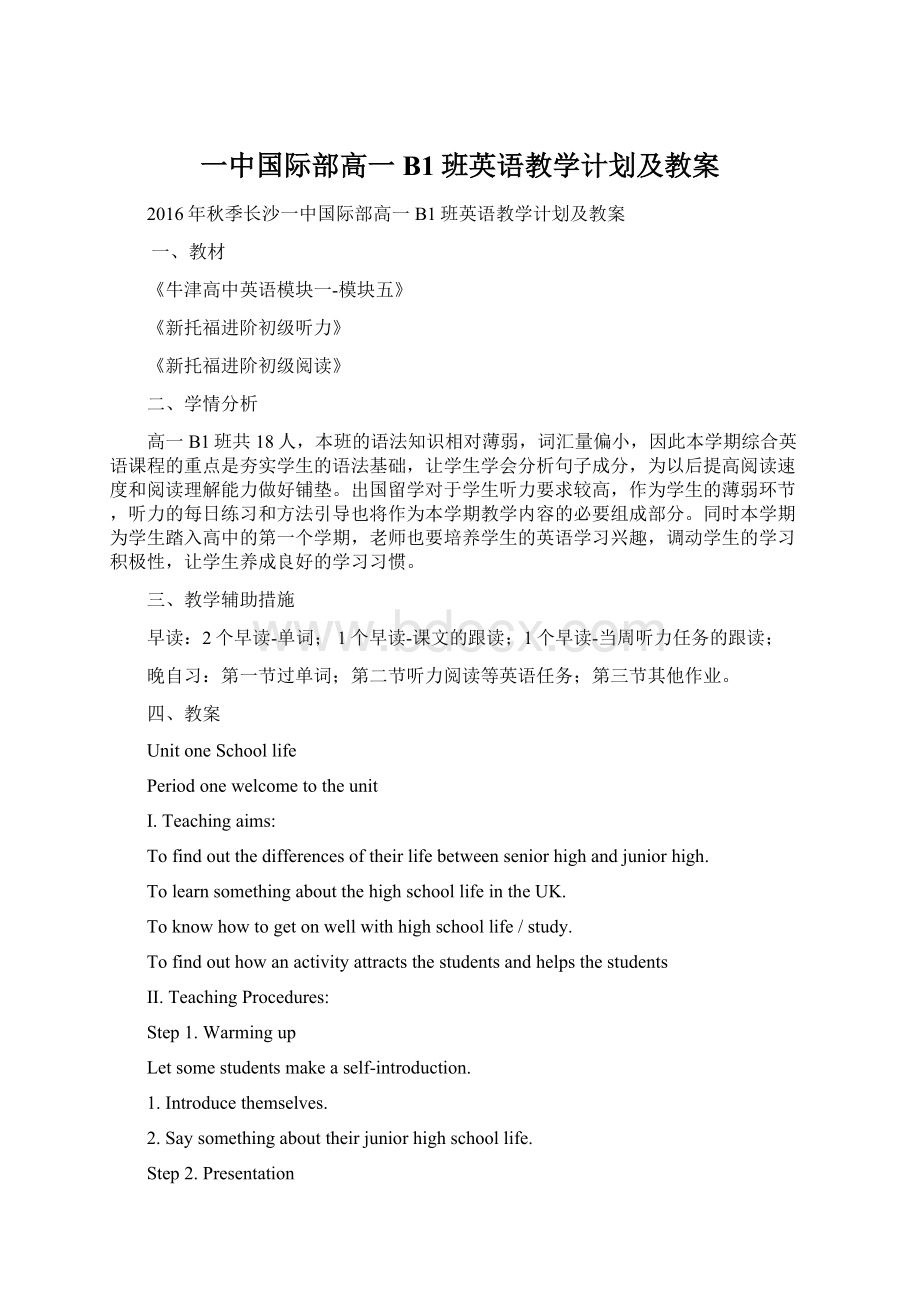一中国际部高一B1班英语教学计划及教案.docx
《一中国际部高一B1班英语教学计划及教案.docx》由会员分享,可在线阅读,更多相关《一中国际部高一B1班英语教学计划及教案.docx(35页珍藏版)》请在冰豆网上搜索。

一中国际部高一B1班英语教学计划及教案
2016年秋季长沙一中国际部高一B1班英语教学计划及教案
一、教材
《牛津高中英语模块一-模块五》
《新托福进阶初级听力》
《新托福进阶初级阅读》
二、学情分析
高一B1班共18人,本班的语法知识相对薄弱,词汇量偏小,因此本学期综合英语课程的重点是夯实学生的语法基础,让学生学会分析句子成分,为以后提高阅读速度和阅读理解能力做好铺垫。
出国留学对于学生听力要求较高,作为学生的薄弱环节,听力的每日练习和方法引导也将作为本学期教学内容的必要组成部分。
同时本学期为学生踏入高中的第一个学期,老师也要培养学生的英语学习兴趣,调动学生的学习积极性,让学生养成良好的学习习惯。
三、教学辅助措施
早读:
2个早读-单词;1个早读-课文的跟读;1个早读-当周听力任务的跟读;
晚自习:
第一节过单词;第二节听力阅读等英语任务;第三节其他作业。
四、教案
UnitoneSchoollife
Periodonewelcometotheunit
I.Teachingaims:
Tofindoutthedifferencesoftheirlifebetweenseniorhighandjuniorhigh.
TolearnsomethingaboutthehighschoollifeintheUK.
Toknowhowtogetonwellwithhighschoollife/study.
Tofindouthowanactivityattractsthestudentsandhelpsthestudents
II.TeachingProcedures:
Step1.Warmingup
Letsomestudentsmakeaself-introduction.
1.Introducethemselves.
2.Saysomethingabouttheirjuniorhighschoollife.
Step2.Presentation
1.Pairwork:
brainstorm:
Whenwearetalkingaboutourschoollife,whatwillweprobablythinkof?
2.Groupwork
WatchavideoanddiscussthreepicturesthatshowsomeaspectsofschoollifeintheUK.Pleasereadtheinstructions,lookatthepictures:
what’sthedifferencebetweenschoolsinChinaandtheUK?
3.Speakingpractice:
Whatisyourdreamschoollifelike?
Whatkindofschoolactivitiesdoyouenjoy?
Whatdoyouthinkofyourlifehereinthenewschool?
4.Homework
1)Recallallthenewwordsandexpressionsthatappearinthisunit.
2)HowmuchdoyouknowabouttheschoolandschoollifeintheUK?
Trytosurfthenet,gotothelibraryorinterviewforeignstudents.
3)Previewthefollowinglesson.
Periodtwo-threeReading:
schoollifeintheUK
Teachingaims:
1.ToreadamagazinearticleaboutschoollifeintheUK.
2.Tolearntoapplytwobasicreadingskills:
skimmingandscanning.
3.Tolearnsomeexpressionsaboutschoollife.
Teachingprocedures:
Step1.Revision
Checkthehomeworkexercise.
Step2.Readingstrategy
Skimming:
togetageneralideaofthearticle.
scanning:
tolocatespecificinformationaboutanarticle.
Step3.Reading
1.Skimmingquestion:
HowdoesWeiHuafeelaboutherlifeintheUK?
Matchheadingswitheachparagraph.
2.Scanning:
ScanthepassageandcompletePartC1,C2onpage4
Step4.Groupwork:
what’sthesimilarityanddifferencebetweentheschoolsinChinaandtheUK?
Step5.Practice:
Pairwork
Nowyouareareporterfromtheschoolmagazine,andhaveachancetointerviewWeiHua.WhatotherinformationwouldyouliketoknowaboutherlifeandstudyintheUK?
SupposeyourdeskmateisWeiHua,makeadialogue.
Step6.LanguagePoints
phrases,words,sentences.
Periodfour-sixGrammarandUsage
Periodfour
Teachingaim:
Togiveabriefintroductiontoattributiveclauses.
Teachingprocedures:
1.Tellthestudentswhatisattributiveclause.
2.Tellthestudentsthebasicusageofrelativepronounssuchaswhich,who,that,whom,whoseandrelativeadverbslikewhen,whereandwhy.
3.AskthestudentstoreadthearticleonPage9andfindouttheattributiveclausesinthearticle.
4.Checktheanswerswiththestudents.
5.Explainsomelanguagepointsinthearticle.
6.Givethestudentssomemoreexercisesofattributiveclause.
7.Assignment.
Periodfive
Teachingaim:
Tomakethestudentsgetfamiliarwithattributiveclausesandgetthemtoknowsomemoreusagesofrelativepronouns.
Teachingprocedures:
1.Checkthehomeworkwiththestudents.
2.Askthestudentstoreadthe5pointsonPage10,tellthemtheusagesofdifferentrelativepronouns.
3.FillintheblanksonPage11,checktheanswerswiththestudentsandexplainthelanguagepoints.
4.Tellthestudentsseveralpointsthattheymustpayattentiontowhentheyuseattributiveclauses.
5.Someexerciseswhicharetoreviewwhattheylearninthislesson.
6.Assignment.
Periodsix:
exercises
Project
Teachingaims:
Tolearntwoarticlesaboutafter-schoolactivitiesinschool
Tolearntheuseofasandrequire
Tofindouthowanactivityattractsthestudentsandhelpsthestudents
TeachingProcedures:
Step1:
Listentotherecordingofthearticlesonpage18
True/Falsequestions.
Step2:
Readthetwoarticlesandanswerthefollowingquestions:
Whatdothestudentmembersintheradiostationdoduringexamtime?
Whatdotheydowhenparentscometovisittheschool?
Whostarted“PoetsoftheNextGeneration”?
Whatdothemembersofthegroupdowhentheymeet?
Step3:
Vocabularyandlanguagepoints:
PeriodeightTOEFLReading
教学目的:
1.扩充学生词汇量
2.学生分析长难句,尤其是后置定语修饰成分,状语的认识
3.使学生熟悉托福猜词题的题型及技巧
教学重点:
答疑,长句分析
授课方法:
grammar-translationmethod
教学过程:
1.五分钟小组讨论交流,组内针对答案不一致的问题进行讨论分析。
2.老师引导学生抓文章主旨,把握文章结构。
3.老师引导学生根据问题的提示词定位原文信息。
4.老师挑选文内长句,学生翻译练习,并讲解分析。
5.课后作业由学生挑选生词并查阅摘录在单词积累本上。
Unit2Growingpains
Welcoming&Reading
Teachingaims:
1Tolearnhowtoreadaplay
2.Topracticeusingkeywordstolocateinformation(scanningskill)
tolearnthewordsandphrases
3.EnableSstomastersomeimportantlanguagepoints.
4.MakesuretheSscandealwiththeproblemsthathappenintheirfamilycorrectlyandpeacefully.
Teachingmethods:
1.AskSstodofast-readingtogetgeneralideaoftheplay.
2.Askthemtodocareful-readingtounderstanddetailedinformation.
3.Pairorgroupworktoparticipateinclass.
Teachingprocedures:
StepOne:
Lead-in
Doyourparentstrytoforceyoutodothingsyoudon’tlike?
Whenyouhaveaproblemandwanttotalktosomeone,whodoyouchoosetotalkto?
Whatkindofbehaviorsofyourswillmakeyourparentsunhappy?
Whatdidyouusuallydoifyourbehaviorupsetsyourparents?
StepTwo:
Fast-reading
1.AskSstoreadtheplayquicklyandfindanswerstoPartA.
2.Checkthemtogether.
StepThree:
Carefulreading
1.AskSstoreadtheplayasecondtimeandtellthemtopayattentionthattheplayhastwoacts,eachwithdifferentthemes,encouragingthemtoreaditoutloud.
2.FinishPartC1-C2
3.Checkanswerstogether.
StepFour:
Readingstrategy
1.AskSstodiscuss,readthereadingstrategyonpage23andknowhowtoreadaplay.
2.roleplay.
3.Tofindmoresentencessaidbyeachcharacteroftheplay
4.ThenfinishPartD1-D2-E
StepFive:
languagepoints
StepSix:
Consolidation
AskSstofinishpartE.
Languagepractice
Translatethefollowingsentencebyusingwhatyouhavelearntinthetext.
StepSeven:
Homework
Gooverwhattheyhavelearntinclass.
PreviewWordpart.
Grammarandusage
Teachingaims:
1.TohelpSstoknowmoreaboutattributiveclause.
2.TolearntheAttributiveClauseswithpreposition+which/whom
3.TolearntheAttributiveClausesintroducedbyrelativeadverbs“where,whenandwhy”
Teachingimportantanddifficultpoints:
1.HelptheSsunderstandtheattributiveclausesintroducedbyapreposition+whichandapreposition+whom.
2.HelpSstoknowthedifferencebetweenthesetwokindsofattributiveclauses.
Teachingmethods:
Presentationandteamwork;Practice;Comparison.
Teachingprocedures:
StepOne:
Presentation
a)AskSstoreadpoint1-5toknowmoreaboutattributiveclauses.
i.AskSstoreadpoint1onpla28toknowwhentouseapre+WHICH/WHOMtobeginanattributiveclause,letthempintouttheantecedentsinthetwosentenceswithanattributiveclauseineachandthefunctionoftheantecedentintheattributiveclause.
ii.LetSsgooverpint2andaskthemwhatthetwosentenceswouldbeinformalEnglish.
iii.LetSsgooverpoint3&4.Askthemtomakethefourexamplesentencesindifferentways.
Forexample:
DadisapersontowhomIcaneasilytalk.
DadisapersonIcaneasilytalkto.
iv.AskSstogooverpint5toknowhowtousetheattributiveclausetomodifytheantecedentway.
b)AskSstolookatthescreenandknowhowtousetheseclauses.
StepTwo:
Practice
AskSstofinishPartAandBonpage29andthencheckanswerstogether.
StepThree:
Tips
介词+关系代词引导的定语从句
1.关系代词在定语从句中做介词宾语时,从句常由介词+关系代词引导
(1)Theschool(that/which)heoncestudiedinisveryfamous.
(2)Theschoolinwhichheoncestudiedisveryfamous.
(3)TomorrowIwillbringhereamagazine(that/which)youaskedfor.
(4)TomorrowIwillbringhereamagazineforwhichyouasked.
(5)We’llgotohearthefamoussinger(whom/that/who)wehaveoften
talkedabout.
(6)We’llgotohearthefamoussingeraboutwhomwehaveoftentalked.
注意:
1.含有介词的动词短语一般不拆开使用,如:
lookfor,lookafter,takecareof等
(1)Thisisthewatchwhich/thatIamlookingfor.(T)
(2)ThisisthewatchforwhichIamlooking.(F)
2.若介词放在关系代词前,关系代词指人时用whom,不可用who或者that;指物时用which,不能用that;关系代词是所有格时用whose
(1)Themanwithwhomyoutalkedismyfriend.(T)
(2)Themanwho/thatyoutalkedwithismyfriend.(F)
(3)TheplaneinwhichweflewtoCanadaisverycomfortable.(T)
(4)TheplaneinthatweflewintoCanadaisverycomfortable.(F)
3.“介词+关系代词”前可有some,any,none,both,all,neither,most,each,
few等代词或者数词
(1)Helovedhisparentsdeeply,bothofwhomareverykindtohim.
(2)Inthebaskettherearequitemanyapples,someofwhichhavegone
bad.
(3)Therearefortystudentsinourclassinall,mostofwhomarefrom
bigcities.
StepFour:
Consolidation
MorePractice
StepFive:
Presentation
(2)
Relativeadverbs:
When,whereandwhy
1.AskSstogothroughfourpointsonpage30andknowinwhatconditionallthreerelativeadverbscanbesuedandmakethemknowwhatotherwordscanbesuedtoreplacewhen,whereandwhy.
2.AskSstolookatthescreenandlearnmoreaboutthiskindofclause.
3.AskSstofinishexerciseonpage31.
StepSix:
Tips
StepSevenConsolidation:
MorePractice
Project
Teachingaims:
1.MakesureSsunderstandwhatgrowingpainsareallabout.
2